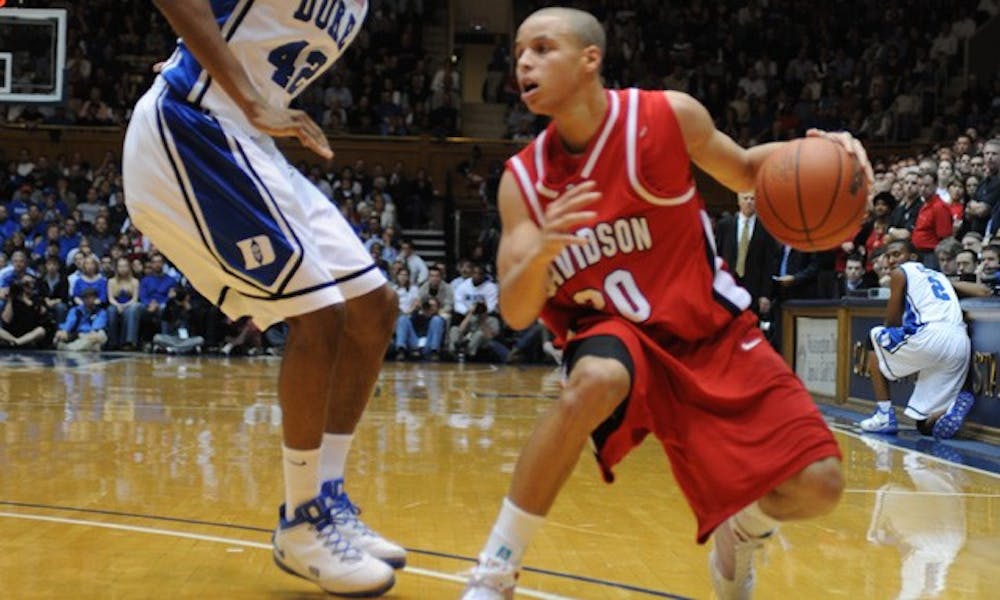In 2008, as Davidson College star Stephen Curry steered the Wildcats to an Elite Eight appearance in Detroit, the school’s admissions office dealt with an unexpected problem back in North Carolina. The tiny college, comprised of 1,668 students, was forced to process an increased number of applications and acceptances, in part because of the elevated exposure Curry and the Wildcats provided. Even a year later, despite an economic downturn, Davidson reported a surge in undergraduate applications.
“We hear sometimes from applicants that they first learned of Davidson after the NCAA Tournament,” Davidson Dean of Admissions Christopher Gruber said. “It’s definitely something we use to distinguish ourselves. When you think of schools our size with Division-I athletic programs, there aren’t many.”
In the ultra-competitive environment of college admissions, students and universities strive to separate themselves from the overqualified pack. Prospective students rely on test scores and extracurricular credentials, while institutions like Duke point to research initiatives, merit of faculty and number of books in their libraries.
Duke, however, has a few key assets that separate it from most top-10 academic institutions—namely, the three national championship banners hanging in Cameron Indoor Stadium.
Although few students declare outright that they came to Duke because of the basketball program, Dean of Undergraduate Admissions Christoph Guttentag said he knows that the exposure generated from successful, high-revenue athletic programs positively affects the outlooks of prospective students.
“[The men’s basketball team] is an incredibly visible part of the University, and not only that, but it’s an incredibly positive part of the University,” Guttentag said. “What drives kids to Duke is that amazing combination we have—the terrific athletic programs and the sense of school spirit all in the context of one of the best academic environments in the world.”
Still, because Duke has enjoyed consistent success on the hardwood since the late 1980s, it is not necessarily subject to the fluctuation Davidson has experienced in recent years. Undergraduate applications to Duke have generally not been impacted by individual basketball seasons, Guttentag said.
The Blue Devils won their first national championships in 1991 and 1992, and in that time span, undergraduate applications remained virtually the same from year to year. In fact, for students entering in the fall of 1993, the University reported a drop of 721 applications, even though the Blue Devils were on the heels of five straight Final Four appearances and consecutive national titles.
After the 1994-1995 season, during which the Blue Devils finished 13-18 and head coach Mike Krzyzewski took a leave of absence for medical reasons, the admissions office reported that it had received 856 fewer undergraduate applications than the previous year. Guttentag, however, doubted that there were many students basing their decision on one losing season. The raw application statistics rarely correlate directly to basketball successes, and actually prove to be counter-intuitive in some cases.
After the 2001 national championship, there was a jump of more than 1,000 applications. Since then, applications have increased every year except for 2007, even though the Class of 2008 was the first class not to experience a Final Four run in a decade.
Duke’s last Final Four season, in 2004, preceded an eight percent growth in applications. But the 2006-2007 basketball season, in which Duke lost in the opening round of the NCAA Tournament to Virginia Commonwealth, was still followed by a six percent gain.
Instead, since Krzyzewski elevated the program to the national spotlight, the consistent media exposure afforded to the team makes high school students think twice before passing on Duke, Guttentag said.
Duke’s lack of reliance on superb seasons to attract applicants contrasts with the athletic success of some lesser-known universities and colleges. After a Cinderella run to the Final Four in 2006, George Mason saw a Davidson-like jump of more than 20 percent in undergraduate applications the following year.
“It’s a good problem to have,” George Mason Dean of Admissions Andrew Flagel said at the time. “There’s no doubt that being in the Final Four really accelerated that trajectory in a way that none of us could really have anticipated.”
With head football coach David Cutcliffe’s decision to remain at Duke—and the media attention that situation attracted—and Krzyzewski’s involvement with USA Basketball, Guttentag expects an increasing number of prospective Blue Devils to apply for chances to jump up and down in Cameron Indoor Stadium.
“It’s hard to tie admissions numbers to one factor,” Guttentag said. “But I think to the increasing degree at which we’re acknowledged as a school that has a number of terrific programs, it can only help from an admissions standpoint.”
Get The Chronicle straight to your inbox
Signup for our weekly newsletter. Cancel at any time.

